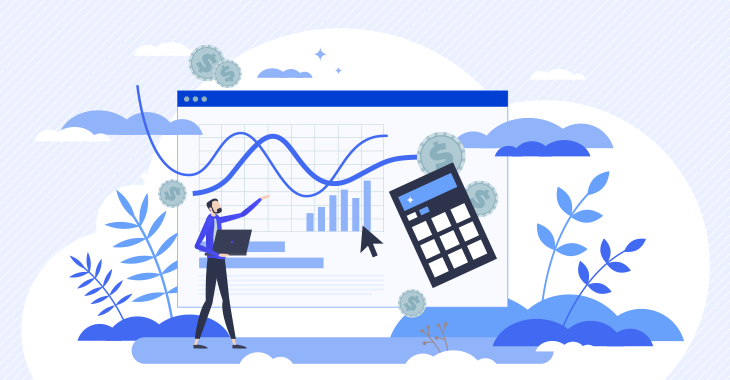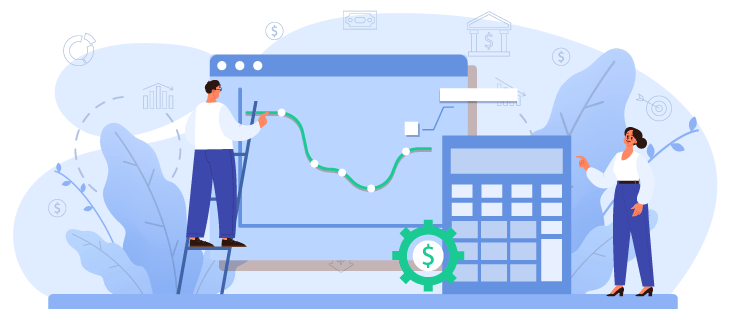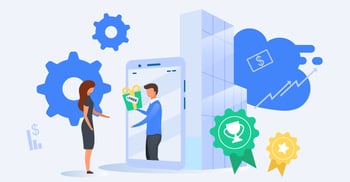A Complete Guide to Calculating Customer Acquisition Cost for SaaS

In most industries, success is a careful balancing act between risk and reward. You can’t create a successful product in the SaaS world without investing time, money, and energy from the get-go.
The trick to SaaS success is finding ways to guard yourself against risk while increasing your odds of reaching your business goals. A handy calculation to use during this process is the customer acquisition cost (CAC) of your SaaS product.
But determining your customer acquisition cost is complicated. You’ll lose out on customers and revenue if you're too cautious. If you’re too confident, you might spend too much, killing your SaaS enterprise before it’s had a chance to grow.
It’s also becoming increasingly difficult for business-to-business (B2B) companies to acquire new customers while achieving SaaS spend optimization. CAC has increased by almost 50% in the past five years.
In this article, we’ll walk you through the ins and outs of all things CAC – what it is, why you need to understand it, how to calculate it, and what to do to get the most out of it.

What Is Customer Acquisition Cost for SaaS?
Your CAC is how much it costs you to acquire a new customer. This metric is measured over a specific timeframe, and a variety of factors should be considered – from advertising and sales costs to salaries and more. Indeed, there are specific values for customer acquisition by industry, but your business strategies could significantly influence this metric. And while the existing SaaS metric benchmarks are relevant, and one should be aware of them, understanding the mathematics behind CAC is important.
Wondering how to calculate the cost of acquiring a customer?
The basic formula for calculating CAC for SaaS is as follows:- Total costs of sales and marketing / Total number of acquired customers = CAC
The aim is to spend just the right amount of money to convince new customers to purchase your product without endangering the lifetime value (LTV) of your SaaS product and the resultant subscription revenue.
Ultimately, your CAC should be much lower than your LTV.
Why Is Understanding CAC Important?
Keeping a close eye on and understanding your CAC will help you establish which resources you need to acquire new customers and grow your business.
You can also use your CAC to determine how profitable your business currently is. For example, look at the amount you’ve invested in your recent marketing and sales strategy and compare this to the number of customers you’ve acquired with its implementation. Did it cost you more to acquire these customers than they’ve spent with your business?
Without looking at your CAC, you won’t know if your sales and marketing efforts have been successful. For example, you might have gained a high number of new customers, but the cost of doing so could have been even higher, costing you profit.

Let’s unpack these and other benefits to understanding and using your CAC:
Optimize Business Processes
As mentioned above, grappling with your CAC is a critical element in optimizing your SaaS business, as it provides clues to how successful your business’s acquisition efforts are.
For example, by analyzing your LTV/CAC ratio, you’ll gain insights that will help you to optimize your sales and marketing campaigns. With this information, you’ll be able to fix weak points in your marketing and sales funnel and do away with ineffective sales and marketing techniques.
Ideally, your LTV/CAC ratio should be 3:1 or higher. So, you want to get at least $3 back for every dollar spent on your product. According to the Corporate Finance Institute, a ratio of less than 1.0 indicates that a business is jeopardizing its product’s value.
No 3rd party integrations. No hidden costs. No wasted time.
Just a solution as unique as your business’s needs.
Perfect Your Pricing
Fine-tuning your CAC plays a vital role in perfecting the price of your SaaS product. CAC research pinpoints your high-value customer personas and gives you insight into their price sensitivity.
Doing your CAC research also helps determine the worth of a customer by clarifying how many resources you can profitably spend on them.
If specific customers aren’t willing to pay enough for your product to offset your costs, they shouldn’t form part of your target market. Check out our SaaS pricing guide to perfect your monetization strategy.

Determine Payback Period
You can use your SaaS product’s customer acquisition cost to determine the CAC payback period of your initial investment. It indicates how long it will take for you to recover from start-up costs and start turning a profit.
What Do You Need To Include In Your CAC Calculation?
When determining your SaaS product’s customer acquisition cost, two essential factors come into play:
All sales and marketing expenses. These encompass anything used to acquire new customers, from employee salaries and software tools to the costs of your marketing strategy.
The number of customers acquired. Only new customers acquired during a predetermined period must be taken into consideration when calculating CAC.
How To Calculate Your CAC
First, you’ll need to pick out a specific timeframe for evaluation. The period you choose to analyze can be a month, a quarter, six months, or a year and will provide a benchmark for future analyses (e.g., to track how your CAC has changed over any given year).
Next, you have to add up your total expenses from your marketing and sales efforts. Then, determine how many new customer accounts you’ve acquired during the timeframe.
Finally, it’s time to apply the CAC formula: Total costs of sales and marketing divided by new customers acquired.
This process sounds pretty simple, but more steps go into calculating your CAC than meets the eye. So we’ve compiled six easy-to-follow steps to collect all the data you need to calculate this cost.

6 Steps To Calculate Your CAC
It's time to pick apart the basic formula for calculating customer acquisition costs for SaaS. How do we determine marketing and sales costs? What constitutes a ‘new’ customer?
1. Determine Ad Spend
The first step to calculating CAC is determining how much you’ve spent on your ad strategies, from paid campaigns via social media and search engines to advertising on more traditional marketing channels.
Top tip: Determine the return on investment (ROI) of your advertising efforts. Divide the revenue generated from your ads by the total advertising cost.
2. Calculate Content Creation and Publishing Costs
Step number two involves your content – everything from content creation to publishing and promotion on digital and other channels. Again, you need to include the total cost of your content marketing strategies in your CAC.
Top tip: Make sure you include auxiliary costs to content creation, such as:
Talent acquisition
Team meetings
Equipment like video cameras and sets
Editing software
3. Add Up Employee Salaries
It’s time to pick apart the basic formula for calculating customer acquisition costs for SaaS. How do we determine marketing and sales costs? What constitutes a ‘new’ customer?
Next up is adding employee expenses. You need to include the salaries you pay your employees and independent contractors, along with any other staff-related costs (e.g., training and development).
Top tip: Consider integrating automated chatbots to deal with customer queries. Chatbots could lower staff costs and keep your team focused on more complex tasks.
4. Add Up Technical Costs
Our fourth step when it comes to how you calculate your SaaS product’s CAC is to add up all technical costs for running campaigns. These costs could include money you’ve spent on technology to streamline the sales process and help your marketing teams – for example, any scheduling software you've acquired.
5. Figure Out Maintenance Costs
Step number five centers on maintenance costs. Work out how much it cost you to run and maintain your business within the timeframe you’ve selected.
Top tip: Don’t forget to include any recurring payments for software you’ve purchased. Also, remember to include any domain, server, and upkeep costs, as well as expenses related to securing global SaaS compliance.
6. Add Up New Customers
Finally, it’s time to add up your new customers. Again, only include the new customers you’ve acquired in the specific period you’re analyzing, or your results will be inaccurate.
Optimizing Your CAC
What’s the point in learning about customer acquisition costs for SaaS products if you can’t use your CAC to achieve your business goals?
The main objective in understanding and calculating your CAC should be to optimize all your operations. Use your CAC to streamline each level of your business to increase profit, reduce costs, and scale your company.
Here are our top tips on how to optimize your CAC.

Assess Your Customer Personas
Crafting accurate Customer Personas is a critical step in establishing and building your SaaS product and brand. But simply creating your buyer personas at the start of your product journey isn’t enough.
You need to continuously assess and analyze your personas to see if they’re still accurate. By checking if they’re relevant and adapting them accordingly, you’ll be able to turn prospects into paying customers, increasing revenue and reducing your CAC.
Collecting quantitative and qualitative data helps you understand how your customers think – what moves them, the features they’re after, and the problems they need you to solve.
Persona assessment helps you determine:
The ideal sales cycle for optimal conversion.
The customer’s sensitivity to price.
The number of customers that visit your channels.
Optimize Your Marketing and Sales Funnel
Optimizing your marketing and sales funnels can increase your conversions. By analyzing these funnels, you can see where you need to strengthen their weak points. Start by identifying where you’re losing customers. Then do a complete analysis to figure out why.
Try quantifying each step of the customer journey. Look into the steps potential customers take on your website, search, and social media channels. Ask questions like how many visitors become leads? How many leads become customers? And why is this so?
Once you know the answers, you can start experimenting with new and proven tactics to fix low conversion rates. Now employ different techniques that speak directly to a specific problem. For example, if responding to customer queries is a problem, install automated chatbots to improve efficiency.

Optimize Your Pricing Strategy
Fine-tuning your pricing strategy is a great way to improve your SaaS customer acquisition cost. In addition, optimizing your pricing strategy will make it easier to recover your CAC.
Try implementing a conversion rate optimization (CRO) strategy. A CRO strategy will help you to convert leads into paying customers. Utilizing the ‘freemium’ business model is an effective CRO tactic. This model involves offering free but limited access to your product to hook in new users.
No 3rd party integrations. No hidden costs. No wasted time.
Just a solution as unique as your business’s needs.
Actively Engage Customers and Prospects
Focusing on your engagement strategies is another crucial step towards optimizing your CAC. The faster new and existing customers start to engage with your SaaS product, the lower your acquisition costs per customer become.
To increase engagement, make sure you’re delivering consistent value to your customers. Provide them with precisely what they want, need, and expect from your brand and product.
Here are some tips to increase customer engagement:
Collect feedback from customers about concerns they may have about your SaaS product.
Ask customers for advice on what can be done to improve your product.
Use customer referral programs. With this technique, your customers act as an extension of your sales team, using word of mouth to spread positive reviews about your product.
Final Thoughts on Calculating Your Customer Acquisition Cost for SaaS
Without optimizing your CAC, you can’t hope to compete in the highly competitive SaaS world. It’s a harsh reality that startups failing to grasp and utilize this metric don’t always survive. You need a complete view of your CAC throughout your growth journey to scale your business. Additionally, you need to be able to rely on a strong infrastructure designed to help you recover revenue.
To learn more about how you can optimize your CAC, contact us at PayPro Global today. We know how to help you reduce your CAC and eliminate the fraud SaaS risk and we’d love to help you create the healthiest, most profitable version of your business.
FAQ
What is a good CAC for a SaaS business?
While there is no definitive answer, a Customer Acquisition Cost for small SaaS businesses is around $10 for every $30 they spend. CAC for SaaS businesses should sit at around 1:3.
How do you calculate customer acquisition costs?
To calculate your customer acquisition cost, simply add up all of the costs associated with acquiring new customers and then divide them by the number of new customers you gained over a specific period of time.
What is the rule of 40 in SaaS?
In an ideal scenario, the growth rate of a SaaS company’s free cash flow should equal 40% or higher when added to the original overall amount.
Hanna Barabakh
Hanna Barabakh is a language and content specialist passionate about SaaS, technology, and e-commerce. Her expertise in multilingual content, connected to her background in Lexicography and Translation Studies, allows her to communicate complex ideas across cultures easily. She uses her knowledge to create engaging content that resonates with global audiences. In her spare time, she enjoys reading and exploring new ideas.
-
1.Explore PayPro Global's Solutions: See how our platform can help you streamline your payment processing and boost revenue.
-
2.Get a Free Consultation: Discuss your specific needs with our experts and discover how we can tailor a solution for you.
-
3.Download our Free Resources: Access valuable guides, checklists, and templates to optimize your online sales.
-
4.Become a Partner: Expand your business by offering PayPro Global's solutions to your clients.
Get the latest news


